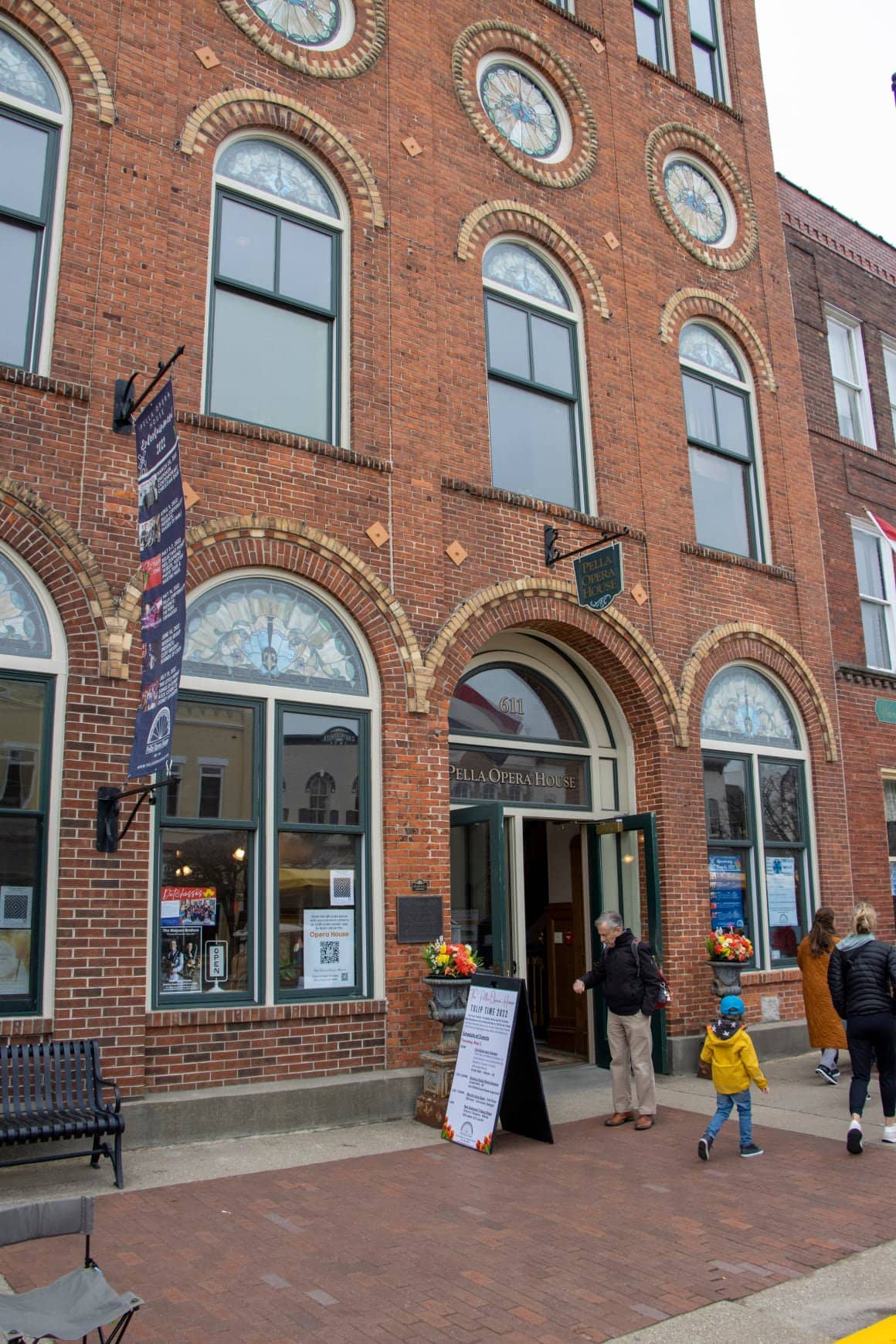
The Pella Opera House is hosting a historic photo display as part of the 87th Tulip Time celebration. Director Cyndi Atkins says the project made possible by the Pella Community Foundation highlights the Tulip City through the decades. She says it’s part of several ongoing events and entertainment at the Pella Opera House through Saturday evening. The Pella Opera House is bringing back The Reluctant Pioneer, the story of Maria Scholte, a Neil Diamond tribute show, and the Central College Flying Pans Steel Band. The Martini Huis is open all three days as well. Tickets are available at the Pella Opera House box office and online at pellaoperahouse.org.
DETAILS OF THE PHOTOS FROM THE PELLA OPERA HOUSE:
The Scholtes – 1
Dominie Hendrik Pieter Scholte
In an attempt to pursue religious freedom, Scholte, his family and 800 followers made the voyage across the Atlantic Ocean to the United States. Settling in a land engulfed by prairie, Scholte was determined to create a thriving town immediately upon arrival in August 1847. In the early years of the town, Scholte built a church, created two businesses, and became the postmaster and land agent to new settlers.
Maria Scholte
The beautiful Maria Scholte married Dominie Scholte in 1845, a year after the death of his first wife. Maria did not completely follow Hendrik’s lifestyle or want to leave the Netherlands; however, emigrating to the United States was inevitable. Used to a lavish lifestyle in the Netherlands, she was intrigued by the culture of the East coast. Journeying across the country and settling in a barren area was difficult for Maria who never quite felt at home in Pella.
Pella Opera House – 2
Undoubtedly one of the most beautiful buildings in Tulip City is the Pella Opera House. Its lavish exterior carries into the inside making it a must see during a trip to Pella. The Pella Opera House’s beginnings started in the 1890s when there was talk throughout Pella of building one. Finally in 1900, a man by the name of Herman Rietveld decided to make the plans a reality and ground was broken in the summer.
The building is 65 feet high and 120 feet long, towering over many buildings on Franklin Street. It would be hard to miss the beauty of the building with its colorful brick, stained glass windows, and large arches sitting above each window. The building was designed in three floors, each serving its own purpose. The first floor held offices and a meeting hall, the second floor held an auditorium, and the third floor was used as lodge rooms. Labeled one of the grandest auditoriums in Iowa, the Pella Opera House was a show stopping room decorated with pale green and terra cotta. The ceiling, decorated in a beautiful, textured pattern held a stunning chandelier.
The opening play was “What Happened to Jones” and premiered November 16, 1900. Throughout its starting years, the Pella Opera House held various shows including silent movies, plays, music, and even a hypnotist in 1910. Prices varied from thirty-five cents to one dollar depending on what show was being held. Attendance was typically strong and many left pleased with the entertainment provided.
After closing in 1918 due to the influx of talkie movies, The Pella Opera House became home to many different businesses, until closing in the 1980s. At that point a group of citizens banded together, raised over $2 million and renovated the Pella Opera House. Reopening in 1990, the Pella Opera House now finds its mission as a historical facility in a unique, intimate setting providing quality arts, entertainment and social events to Pella and our surrounding communities.
Franklin Street – 3 (3 photos over the years)
Franklin Street is home to many of the retail stores in Pella. From the early days of horse and buggies to Model As and Model Ts to the classics of the ’40s and ’50s, downtown Pella has always been the place to park and shop.
Paardekooper’s Drug – 4
The name Paardekooper’s Drug can still faintly be seen on the building of the current local business, Smokey Row. Paardekooper’s Drug was started by Martin Paardekooper who had been in the local drug business for over thirty years. He moved his drug store to the southeast corner of Franklin and Main in 1942 where he created a store to fit his needs in a recognizable, beautiful location.
Central Park Café – 5
Searching for a modern place to eat, the Meulpolder brothers opened the Central Park Cafe on June 22, 1925. This popular cafe promised to use their modern equipment to serve quality meals even on Sundays. The trademark of the cafe was the small windmill sitting on top of the front entrance.
Motorized Mailmen – 6
This historical photo showcases the first motorized mailmen in Pella.
The Citizens National Bank – 7
There was a man in our town,
H. Rietveld was his name;
His enemies thought they had him down,
But he bobbed up just the same.
He built a bank on Main Street;
‘Twas full three stories high.
He mad the brick himself you see––
And that’s the reason why.
He organized a national bank
With stockholders good and strong––
He had no one but himself to thank,
And that’s where the credit belongs.
He also started a savings bank,
And shoved Rich into the collar.
His business is to give you a book
And help you save the dollar.
Two dogs of war adorn the front
Of this wond’rous institution,
But the boys inside will stand the brunt
Of all the persecution.
The National Bank will open soon
In its room in the second story:
And business then will certainly boom,
And Rietveld will be in his glory.
The president in his private chair,
As head of the institution,
Van Spanckeren in his office where
He will interest computation.
Then business will take on a rosy hue,
And people will come to deposit;
The debtor will pay all his notes when due,
Or he’ll want to know, “How was it.”
The people will learn to be not afraid
For he’s learned this reputation:
Whether rich or poor he lends his aid
To a worthy man––whatever station.
Here’s to the bank that can’t be downed,
In whichever way you take it.
With a million dollars full and round
To hold up––not to break it.
So here’s to the people’s choice, you see,
For the people must be respected.
The people’s business here will be;
No good thing has been neglected.
So here’s to the bank which is bound to win
In taking its place in the rank,
And accommodate all who may enter in––
It’s the “Citizens National Bank”
The Pella Chronicle Vol. 41. Number 42, Dec. 21, 1905
Fire Station – 8
The original fire station was built in 1882 after a series of fires in 1872, 1880, and 1882 destroyed many local businesses. Equipment used were a hose cart, pulled by either horse or man power, and various hoses. Water was originally hand pumped until 1895 when a water system was created and a water tower was built. This created a need for new cotton hoses but they were difficult to drain and dry, so in 1904 a hose tower was constructed. The fire station was replaced in 1954 when a new facility was built.
Pella Overall Company – 9
Organized in 1908, the Pella Overall Company was located on the West side of the square. The industry was created by a group from Pella who wanted to provide jobs for community members. The company originally employed twelve people and one salesman but after twenty years, over fifty people were employed. The brand name was Garden City Overalls, specializing in overalls, coveralls, jackets, pants, and lined coats. A little Dutch boy became the company’s logo which became recognizable across the Midwest.
Ulrich’s Meat Market – 10
Located on the south side of the square, Ulrich’s Meat Market found its home in October 1880. Founded by John Ulrich, his business has been thriving for over 150 years. In the October 26, 1880 Weekly Pella Blade newspaper, John Ulrich writes of the fresh beef, pork, smoked meats, sausage, and everything found in a first-class meat market. One product built on tradition is Ulrich’s Pella bologna which strives to create a flavor full of history and quality.
The Local Hangout – 11
Men have been hanging around this local hangout for decades. While the businesses have changed over the years, this space is not partially home to the Cellar Peanut Pub.
Franklin Street – 12
A last look at the busy retail stores on Franklin Street, including a glimpse of Vander Ploeg Bakery.
Our thanks to the Pella Community Foundation for grant support of the historic photo display. We also wish to thank John Vroom for the photo files from his collection, Metjse Miller for research on the history of these buildings, Cyndi Atkins and Jara Johnson for hanging the display and to the Vermeer Ricoh Center for assistance in printing.

